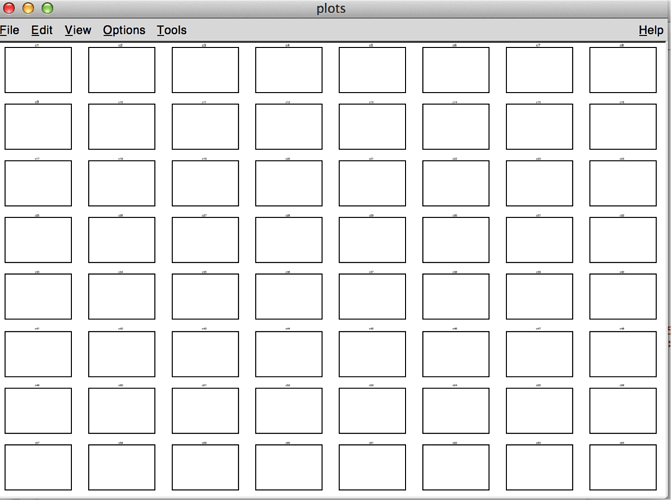Hi Experts of root in here,
Bear with the newb. I know this is probably a really simple thing…
But I have tried a lot of different things and asked a lot of different ppl and it doesn’t work:
How do you set range in a histogram set up by tuple?
I tried using  (TH1F *)(gPad->FindObject(TString::Format(“h%i”, i))))->GetXaxis()->SetRange(5E+15,15E+16);
(TH1F *)(gPad->FindObject(TString::Format(“h%i”, i))))->GetXaxis()->SetRange(5E+15,15E+16);
As is seen in the commented out part, but no change is made to the 64 graphs.
Attached is the .dat file i used as input file
Thanks in advance.
Attached is my code:
[code]#include “TFile.h”
#include “TNtuple.h”
#include “TH1.h”
#include “TCanvas.h”
#include “TPad.h”
#include “TString.h”
#include
#include
void histo641(void){
Float_t c[65];
Int_t i, nlines = 0;
TFile *f = new TFile(“histo.root”,“RECREATE”);
TNtuple *ntuple = new TNtuple(“ntuple”, “data from ascii file”, “c0:c1:c2:c3:c4:c5:c6:c7:c8:c9:c10:c11:c12:c13:c14:c15:c16:c17:c18:c19:c20:c21:c22:c23:c24:c25:c26:c27:c28:c29:c30:c31:c32:c33:c34:c35:c36:c37:c38:c39:c40:c41:c42:c43:c44:c45:c46:c47:c48:c49:c50:c51:c52:c53:c54:c55:c56:c57:c58:c59:c60:c61:c62:c63:c64”);
ifstream in;
in.open(“gain1.dat”);
while (1) {
in >> c[0]>>c[1]>>c[2]>>c[3]>>c[4]>>c[5]>>c[6]>>c[7]>>c[8]>>c[9]>>c[10]>>c[11]>>c[12]>>c[13]>>c[14]>>c[15]>>c[16]>>c[17]>>c[18]>>c[19]>>c[20]>>c[21]>>c[22]>>c[23]>>c[24]>>c[25]>>c[26]>>c[27]>>c[28]>>c[29]>>c[30]>>c[31]>>c[32]>>c[33]>>c[34]>>c[35]>>c[36]>>c[37]>>c[38]>>c[39]>>c[40]>>c[41]>>c[42]>>c[43]>>c[44]>>c[45]>>c[46]>>c[47]>>c[48]>>c[49]>>c[50]>>c[51]>>c[52]>>c[53]>>c[54]>>c[55]>>c[56]>>c[57]>>c[58]>>c[59]>>c[60]>>c[61]>>c[62]>>c[63]>>c[64];
if (!in.good()) break;
nlines++;
ntuple->Fill(c);
}
printf(" found %d points\n",nlines);
in.close();
TCanvas *c1 = new TCanvas(“c1”,“plots”);
c1->Divide(8,8,.001,.001);
for(i=1; i<=64; i++) {
c1->cd(i);
// c1->cd(i)->SetLogy();
ntuple->Draw(TString::Format(“c%i >> h%i”, i, i));
((TH1F *)(gPad->FindObject(TString::Format(“h%i”, i))))->Fit(“gaus”);
// ((TH1F *)(gPad->FindObject(TString::Format(“h%i”, i))))->GetYaxis()->SetRange(0,7);
// ((TH1F *)(gPad->FindObject(TString::Format(“h%i”, i))))->GetXaxis()->SetRange(5E+15,15E+16);
((TH1F *)(gPad->FindObject(TString::Format(“h%i”, i))))->DrawCopy();
// ((TH1F *)(gPad->FindObject(TString::Format(“h%i”, i))))->GetXaxis()->Rebin(7);
// ((TH1F *)(gPad->FindObject(TString::Format(“h%i”, i))))->DrawCopy();
// ntuple->GetXaxis()->SetRange(5E+15,15E+16);
// ntuple->GetYaxis()->SetRange(0,7)
// ntuple->Fit(“gaus”);
// ntuple->Rebin(5);
}
c1->Modified(); c1->Update();
f->Write();
delete f;
}[/code]
gain1.dat (11.3 KB)
